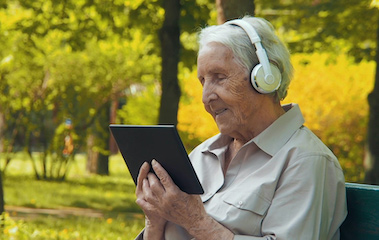Older people increasingly connected to the Internet? It’s happening!
What if the cliché of elderly people unable to send an email or browse the web was now obsolete? According to recent studies, the number of connected seniors is clearly rising. A social development which is not without consequences for establishments specialising in the care of the elderly...
Internet use on the rise among seniors
According to the findings from Ofcom’s 2017 Adults’ Media Use and Attitudes report, the trend is clear. It is apparent in terms of equipment: with four in ten (39%) Baby boomers aged 65-74 using a smartphone, allowing them to access the Internet. In terms of usage, there has been a sharp rise in over-75s using tablets, from 15% to 27%. And the use of smartphones among this age group has nearly doubled, from 8% to 15%. And we must not forget that the seniors of tomorrow are also the young people of today...
Digital tools for connected seniors
As a result, digital tools are increasingly adapting to this new audience. For example, there are smartphones and tablets specially designed for the elderly. In addition, many websites today aim to be accessible and easy to use. It is therefore not surprising to see people over 50 using the Internet to make purchases, carry out administrative procedures or manage their bank accounts.
But beyond the practical aspect, digital access, among seniors, is a way to fight isolation. Hence the growing adoption of social networks. Nearly half (48%) of internet users aged 65-74 now have a social media profile. Among over 75s, the proportion with a profile has nearly doubled – from 19% to 41%. Around nine in ten (87%) social seniors aged over 65 opt for a Facebook account. The term “connected seniors” takes on its full meaning: it designates their ability to use digital tools, but also to stay in touch with their loved ones.
The need to anticipate the move to digital technology for senior residences
In such a context, establishments welcoming the elderly must adapt. This is particularly the case for senior service residences, which offer accommodation solutions and services to this population group.
Until now, for these establishments, the question of connectivity could take a backseat. But from now on, offering Internet access for connected seniors may well act as a determining differentiating factor. And tomorrow, this will be an essential criterion to attract new residents, first in senior residences and very soon in nursing homes. Especially since with the advent of connected objects, this can become a safety issue. Indeed, a number of solutions propose a service able to detect if an elderly person has had a fall and send an alert. It is therefore essential to have a high-performance and secure WiFi network throughout the residence. For the appeal of the establishment, as well as for the health of its inhabitants.
- Wifi (36)
- Hotel Industry (18)
- Digital Workplace (13)
- Behind the scenes (8)
- IPTV - Signage (8)
- Optical fibre (7)
- Green-IT (5)
- Retail (5)
- Education (3)
- Healthcare (2)
- Cybersecurity (1)
- General (1)
- Hospitality (1)
- PBSA (1)
- Student Accommodation (1)
- Telephony (1)
- Tips and tricks (1)
- Tourism (1)
- Wifirst (1)
You May Also Like
These Related Stories

Enhancing Post-COVID Hotel Stays with Advanced Streaming Solutions

What is WiFi as a Service?
